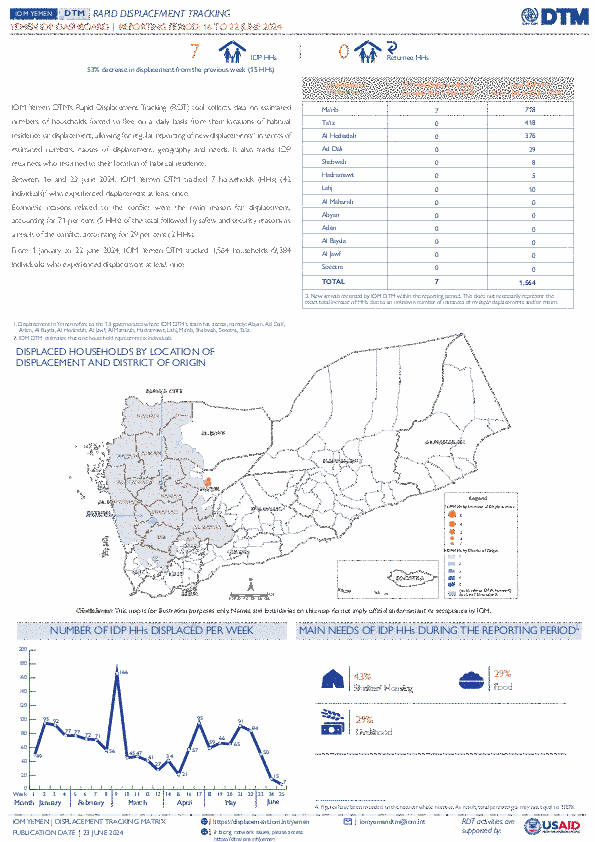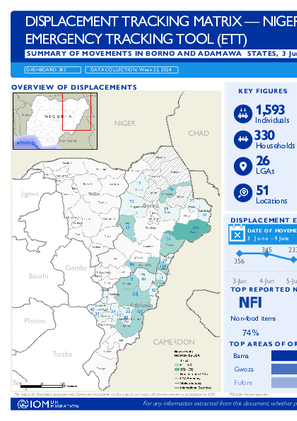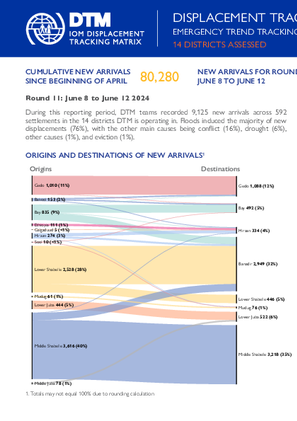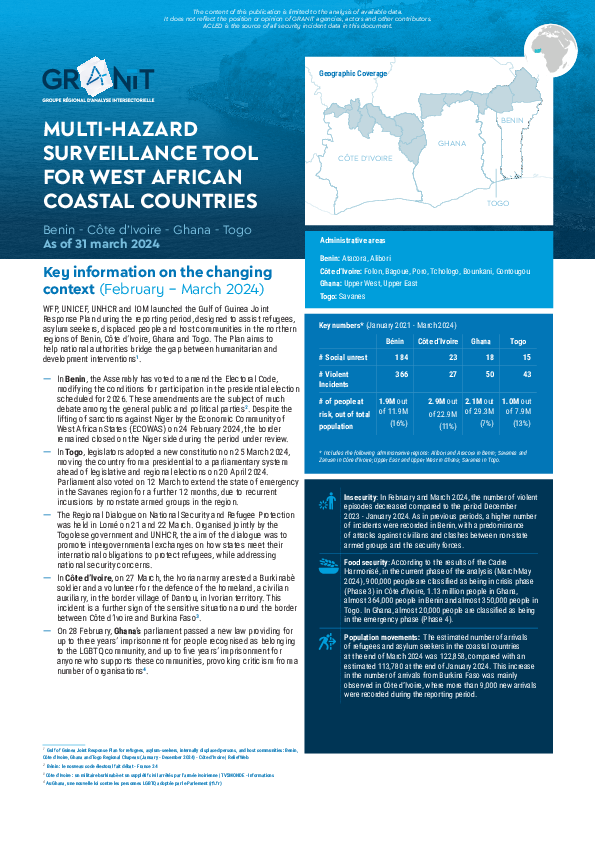-
Countries
-
Data and Analysis
-
Special Focus
-
Crisis Responses
Internal displacement
Domain host
displacement.iom.int
Contact
DTM Yemen, iomyemendtm@iom.int
Location
Yemen
Activity
- Mobility Tracking
- Event Tracking
Period Covered
Jun 16 2024 -Jun 22 2024
From 1 January to 22 June 2024, IOM Yemen DTM tracked 1,564 households (HH) (9,384 Individuals) who experienced displacement at least once.
Between 16 and 22 June 2024, IOM Yemen DTM tracked 7 households (42 individuals) displaced at least once. The majority of people moved into/within the following governorates and districts:
- Ma’rib (7 HHs) – Marib City (4 HHs), Marib (3 HHs) districts. Most displacements in the governorate originated from Al Hodeidah and Dhamar.
The majority of people moved from the following governorates and districts:
- Al Hodeidah (2 HHs) – At Tuhayta (1 HHs), Ad Durayhimi (1 HHs) districts.
- Dhamar (2 HHs) – Otmah (2 HHs) district.
- Ta’iz (1 HH) – Al Qahirah (1 HHs) district.
Population Groups
IDPs
Returnee (Previously Internally Displaced)
Survey Methodology
Unit of Analysis Or Observation
Admin Area 2
Type of Survey or Assessment
Household
Key Informant
Keywords
Geographical Scope Partial Coverage
Administrative boundaries with available data
The current dataset covers the following administrative boundaries

Contact
DTM Yemen, iomyemendtm@iom.int
Language
English
Location
Yemen
Period Covered
Jun 16 2024
Jun 22 2024
Activity
- Mobility Tracking
- Event Tracking
IOM Yemen DTM’s Rapid Displacement Tracking (RDT) tool collects data on estimated numbers of households forced to flee on a daily basis from their locations of origin or displacement, allowing for regular reporting of new displacements in terms of estimated numbers, geography, and needs. It also tracks returnees who returned to their location of origin.
From 1 January to 22 June 2024, IOM Yemen DTM tracked 1,564 households (HH) (9,384 Individuals) who experienced displacement at least once.
Between 16 and 22 June 2024, IOM Yemen DTM tracked 7 households (42 individuals) displaced at least once. The majority of people moved into/within the following governorates and districts:
- Ma’rib (7 HHs) – Marib City (4 HHs), Marib (3 HHs) districts. Most displacements in the governorate originated from Al Hodeidah and Dhamar.
The majority of people moved from the following governorates and districts:
- Al Hodeidah (2 HHs) – At Tuhayta (1 HHs), Ad Durayhimi (1 HHs) districts.
- Dhamar (2 HHs) – Otmah (2 HHs) district.
- Ta’iz (1 HH) – Al Qahirah (1 HHs) district.

Contact
DTM Nigeria, iomnigeriadtm@iom.int
Language
English
Location
Nigeria
Period Covered
May 01 2024
May 31 2024
Activity
- Survey
- Mobility Tracking
- Event Tracking
Conflicts between farmers and herders in North-East Nigeria and other Sahel regions are driven by a combination of environmental and demographic factors, including desertification, climate change impacts, and low rainfall which reduces the availability of suitable land for farming and transhumance activities. Rapid population growth further exacerbates these issues by increasing the demand for food, shelter, and security for both humans and livestock. This heightened competition for scarce natural resources often leads to incidents like farming on cattle routes, crop destruction, farm damage, and water pollution, which often escalate into violent confrontations between farming and herding communities.
The Transhumance Tracking Tool (TTT), a component of IOM's Displacement Tracking Matrix (DTM with the support of community key informants) operationalized the Early Warning System in nine selected Local Government Areas (LGAs) in Adamawa and Taraba states. This system collects alerts related to farmer-herder conflicts.Of the 212 alerts recorded in May, 180 alerts (85%) were event-related, while 32 (15%) were related to movements. In Demsa, Lamurde, Girei, Shelleng, and Numan LGAs in Adamawa state, all instances of alerts were event-related. In Mayo-Belwa LGA, 92 per cent were event-related and 8 per cent were movement-related. Also, Guyuk LGA reported 17 per cent event-related alerts and 83 per cent movement-related. In Taraba state, Zing and Lau LGAs reported 83 per cent and 55 per cent event-related alerts, and 17 per cent and 45 per cent movement-related alerts, respectively. Disaggregated ward-level data indicates that Zing ward in Zing LGA in Taraba state and Kodompti ward in Numan LGA of Adamawa state reported the highest percentage of events, 8 and 7 per cent of the total alerts respectively.
Contact
DTM Yemen, iomyemendtm@iom.int
Location
Yemen
Activity
- Mobility Tracking
- Event Tracking
Period Covered
Jun 09 2024 -Jun 15 2024
From 1 January to 15 June 2024, IOM Yemen DTM tracked 1,557 households (HH) (9,342 Individuals) who experienced displacement at least once.
Between 9 and 15 June 2024, IOM Yemen DTM tracked 15 households (90 individuals) displaced at least once. The majority of people moved into/within the following governorates and districts:
- Ma’rib (15 HHs) – Ma’rib (10 HHs), Ma’rib City (4 HHs), Harib (1 HH) districts. Most displacements in the governorate originated from Al Hodeidah and Hajjah.
The majority of people moved from the following governorates and districts:
- Al Hodeidah (10 HHs) – Hays (3 HHs), Az Zaydiah (2 HHs), Al Mansuriyah (1 HH) districts.
- Hajjah (2 HHs) – Aflah Ash Sham (1 HH), Harad (1 HH) districts.
- Sana’a (1 HH) – Arhab (1 HH) district.
Population Groups
IDPs
Survey Methodology
Unit of Analysis Or Observation
Admin Area 2
Type of Survey or Assessment
Household
Key Informant
Keywords
Geographical Scope Partial Coverage
Administrative boundaries with available data
The current dataset covers the following administrative boundaries

Contact
DTM Yemen, iomyemendtm@iom.int
Language
English
Location
Yemen
Period Covered
Jun 09 2024
Jun 15 2024
Activity
- Mobility Tracking
- Event Tracking
IOM Yemen DTM’s Rapid Displacement Tracking (RDT) tool collects data on estimated numbers of households forced to flee on a daily basis from their locations of origin or displacement, allowing for regular reporting of new displacements in terms of estimated numbers, geography, and needs. It also tracks returnees who returned to their location of origin.
From 1 January to 15 June 2024, IOM Yemen DTM tracked 1,557 households (HH) (9,342 Individuals) who experienced displacement at least once.
Between 9 and 15 June 2024, IOM Yemen DTM tracked 15 households (90 individuals) displaced at least once. The majority of people moved into/within the following governorates and districts:
- Ma’rib (15 HHs) – Ma’rib (10 HHs), Ma’rib City (4 HHs), Harib (1 HH) districts. Most displacements in the governorate originated from Al Hodeidah and Hajjah.
The majority of people moved from the following governorates and districts:
- Al Hodeidah (10 HHs) – Hays (3 HHs), Az Zaydiah (2 HHs), Al Mansuriyah (1 HH) districts.
- Hajjah (2 HHs) – Aflah Ash Sham (1 HH), Harad (1 HH) districts.
- Sana’a (1 HH) – Arhab (1 HH) district.
IOM identified 12 additional households displaced in the previous reporting period, which covered 02 - 08 June 2024, in the governorates of Al Hodeidah (6 HHs), Ma’rib (4 HHs), Ta’iz (2 HHs). These figures have been added to the cumulative displacement total recorded since the beginning of the year.
Contact
dtmlebanon@iom.int
Location
Lebanon
Activity
- Mobility Tracking
- Baseline Assessment
Period Covered
Oct 10 2023 -Jun 11 2024
Since October 8 there has been an increase in cross-border incidents between Israel and Lebanon, resulting in the displacement of people both within the South and elsewhere within the country. Since October 10, the Displacement Tracking Matrix (DTM) has been conducting the daily monitoring of population movements. The objective of the exercise is to inform preparedness and response planning.
Aggregated data is available through the DTM API: https://dtm.iom.int/data-and-analysis/dtm-api
A more detailed version of this dataset is available, to get access kindly click on the 'Request Access' button
Population Groups
IDPs
Returnee (Previously Internally Displaced)
Survey Methodology
Unit of Analysis Or Observation
Admin Area 2
Admin Area 3
Household
Individual
Type of Survey or Assessment
Key Informant
Keywords
Geographical Scope Full Coverage
Administrative boundaries with available data
The current dataset covers the following administrative boundaries
The GRANIT was conceived in 2021 in Dakar at the initiative of OCHA, IOM and REACH with the support of the Regional Sectoral Groups, UN agencies and NGOs. GRANIT seeks to create a forum of technical experts and information managers to pave the way for a regional, holistic and cross-sectoral analytical approach to inform the crisis preparedness and response phases. The aim of the monitoring tool is to track developments in the context in the target countries, using a multi-hazard approach. To this end, 15 indicators have been selected by the regional group of experts in emergency preparedness and response and GRANIT members. This report presents the evolution of the situation in Benin, Côte d'Ivoire, Ghana and Togo, as of 31 March 2024.

Contact
iomnigeriadtm@iom.int
Language
English
Location
Nigeria
Period Covered
Jun 03 2024
Jun 09 2024
Activity
- Registration
- Rapid Emergency Registration
- Mobility Tracking
Between 3 June and 9 June 2024, a total of 1,593 new arrivals were recorded at locations in Adamawa and Borno states. The new arrivals were recorded at locations in Askira/Uba, Bama, Gubio, Gwoza, Kaga, Kala Balge, Mafa, Magumeri, Monguno and Ngala Local Government Areas (LGAs) of the most conflict-affected Borno State and in Demsa, Fufore, Girei, Gombi, Guyuk, Hong, Lamurde, Madagali, Maiha, Michika, Mubi North, Mubi South, Numan, Song, Yola North and Yola South LGAs of Adamawa State.
ETT assessments identified the following movement triggers: military operations (358 individuals or 22%), poor living conditions (349 individuals or 22%), seasonal farming (318 individuals or 20%), improved security (191 individuals or 12%), family re-unification (131 individuals or 8%), fear of attack (119 individuals or 8%), access to humanitarian support (67 individuals or 4%) and attack (60 individuals or 4%).

Contact
DTM Chad, dtmtchad@iom.int
Language
English
Location
Chad
Period Covered
Jun 18 2024
Jun 18 2024
Activity
- Mobility Tracking
- Event Tracking
Over 780,000 people have crossed into Chad since the onset of the crisis in Sudan. IOM estimates that 201,379 among them are Chadian returnees and expects this number to rise to 240,000 through to December 2024. This is due to ongoing conflict and food insecurity in Darfur, owing to the current suspension of the humanitarian corridor between Chad and Darfur.
Returnees are Chadian nationals who were living in Sudan and have been displaced back to their home country where they lack the resources to rebuild their lives. Returnees are living either in displacement sites or within host communities. They are in urgent need of food, water, sanitation and hygiene shelter, household items, health, and protection. IOM is the lead agency for the returnee response, in close coordination with the Government of Chad, local authorities, UN agencies, and local and international NGOs.

Contact
DTM Somalia, IOMSomaliaDTM@iom.int
Language
English
Location
Somalia
Period Covered
Jun 08 2024
Jun 12 2024
Activity
- Mobility Tracking
- Baseline Assessment
This latest round of Emergency Trends Tracking was initiated in April 2024 to monitor displacements movements during the Gu rainy season. Districts covered in this round include Afgooye, Afmadow, Baardheere, Baidoa, Balcad, Belet Weyne, Dayniile, Gaalkacyo, Hodan, Jamaame, Jowhar, Kahda, Kismaayo, Luuq. ETT is a crisis-based tool that tracks sudden displacement triggered by specific events or emerging crises.
The objective of ETT is to help prioritize humanitarian response and to enable partners to deliver rapid assistance. Based on previous shock induced displacement patterns, the humanitarian community expects that people will continue to move toward urban areas in search of humanitarian services. Consequently, the ETT coverage focuses on the main urban centers and surrounding villages for each assessed district. The data is collected through Key Informant Interviews (KIIs) at the location level, from Sunday to Wednesday every week. It includes information on new arrivals, numbers and demographic of IDPs, reasons for displacement, intentions, humanitarian assistance and priority needs among others.
The ETT tool also adapts to regional contexts: because of the very high number of IDP sites in Khada and Daynile districts in Banadir region and in Baidoa district in Bay region, a zonal approach has been adopted for these areas. Each week, KIIs are first conducted at the zone level to indicate to the field teams which locations have received the most new arrivals and which need to be assessed. To facilitate the joint analysis of the CCCM (Camp Coordination and Camp Management) Cluster’s New Arrivals Tracker (NAT) and ETT data, the assistance and needs indicators are identical in both tools.
Pagination
- Previous page
- Page 70
- Next page

